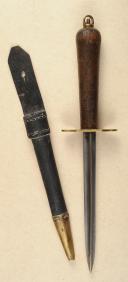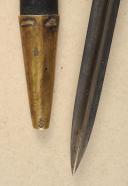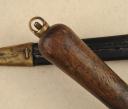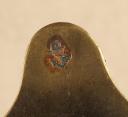
MARINE DAGGER, MODEL 1837, THIRD TYPE, ASSIGNED TO INFANTRY IN 1915.
Sold out
MARINE DAGGER, MODEL 1837, THIRD TYPE, ASSIGNED TO INFANTRY IN 1915.
Black lacquered wood handle, height 117 mm, diameter 29 mm at the top and 21 mm at the bottom near the guard.
Brass nut serving as a ring for the strap and for securing the blade, height 15 mm, diameter 14 mm.
Brass guard, length 65 mm, width 28 mm, thickness 3 mm. It is stamped with a cabled anchor and a starred E, a stamp of acceptance of the equipment used by the French army in 1914/1918.
Triangular blade, length 168 mm, width at the base 17 mm, thickness at the base 8 mm.
Leather scabbard with brass tip, length 184 mm (scabbard with tip), width at the top approximately 23 mm.
Brass tip length 55 mm, width at the top 20 mm.
Weight 176 grams.
Very good condition.
Period 1837-1918.
This dagger is called the Marine Dagger Model 1837 in the naval artillery manuals of 1850 and 1888, and is commonly associated with the 1833 system along with the saber, ax, and pike of the navy.
Manufactured at the Châtellerault factory from 1837 to 1851, 23,931 examples were produced. The dagger is no longer mentioned in the armorer's regulations after 1872.
On October 20, 1915, the naval arsenals transferred 10,500 daggers to the Ministry of War as trench weapons to equip the "POILUS" (French soldiers during WWI).
The original scabbard, blackened with iron sulfate which corroded the blade, was replaced in 1854 by a tin scabbard.
Productions until 1843 are stamped by Simon Wideman, a first-class controller from June 1836 to December 4, 1843, and then by his successor Joseph Antoine Bisch until 1851 when production ceased. These stamps on the blade and guard are well documented.
The blade is made from or with the tools of the 1822 or 1847 bayonet.
Regarding the encountered models:
-1- The first type models are considered the most easily identifiable and authentic with Wideman's stamp on the blade and the brass guard, and an uncabled anchor on the guard and the leather scabbard tip. The nut is made of steel. The guard is perfectly fitted to the blade. (Same for those stamped by Bisch).
-2- The second type model is also authentic (it can sometimes be found with a number indicating the battery, marked on the handle and on the scabbard). No stamps are present on the blade, a cabled anchor is on the guard and an uncabled one on the scabbard tip. The guard is perfectly fitted to the blade. The nut is made of brass and is found on other models.
-3- The third type model has exactly the same characteristics as the second type, concerning the blade and the blackened beechwood handle. The authentic scabbard is of the first type. The blade is not stamped. The guard, whose shape is slightly different, has a cabled anchor and a starred E, a stamp of acceptance of the equipment used by the French army in 1914/1918, and is less well-fitted to the blade. The nut is made of brass.
This dagger is allocated to all warships at a rate of approximately 200 daggers per ship.
Black lacquered wood handle, height 117 mm, diameter 29 mm at the top and 21 mm at the bottom near the guard.
Brass nut serving as a ring for the strap and for securing the blade, height 15 mm, diameter 14 mm.
Brass guard, length 65 mm, width 28 mm, thickness 3 mm. It is stamped with a cabled anchor and a starred E, a stamp of acceptance of the equipment used by the French army in 1914/1918.
Triangular blade, length 168 mm, width at the base 17 mm, thickness at the base 8 mm.
Leather scabbard with brass tip, length 184 mm (scabbard with tip), width at the top approximately 23 mm.
Brass tip length 55 mm, width at the top 20 mm.
Weight 176 grams.
Very good condition.
Period 1837-1918.
This dagger is called the Marine Dagger Model 1837 in the naval artillery manuals of 1850 and 1888, and is commonly associated with the 1833 system along with the saber, ax, and pike of the navy.
Manufactured at the Châtellerault factory from 1837 to 1851, 23,931 examples were produced. The dagger is no longer mentioned in the armorer's regulations after 1872.
On October 20, 1915, the naval arsenals transferred 10,500 daggers to the Ministry of War as trench weapons to equip the "POILUS" (French soldiers during WWI).
The original scabbard, blackened with iron sulfate which corroded the blade, was replaced in 1854 by a tin scabbard.
Productions until 1843 are stamped by Simon Wideman, a first-class controller from June 1836 to December 4, 1843, and then by his successor Joseph Antoine Bisch until 1851 when production ceased. These stamps on the blade and guard are well documented.
The blade is made from or with the tools of the 1822 or 1847 bayonet.
Regarding the encountered models:
-1- The first type models are considered the most easily identifiable and authentic with Wideman's stamp on the blade and the brass guard, and an uncabled anchor on the guard and the leather scabbard tip. The nut is made of steel. The guard is perfectly fitted to the blade. (Same for those stamped by Bisch).
-2- The second type model is also authentic (it can sometimes be found with a number indicating the battery, marked on the handle and on the scabbard). No stamps are present on the blade, a cabled anchor is on the guard and an uncabled one on the scabbard tip. The guard is perfectly fitted to the blade. The nut is made of brass and is found on other models.
-3- The third type model has exactly the same characteristics as the second type, concerning the blade and the blackened beechwood handle. The authentic scabbard is of the first type. The blade is not stamped. The guard, whose shape is slightly different, has a cabled anchor and a starred E, a stamp of acceptance of the equipment used by the French army in 1914/1918, and is less well-fitted to the blade. The nut is made of brass.
This dagger is allocated to all warships at a rate of approximately 200 daggers per ship.
Reference :
10853/3243
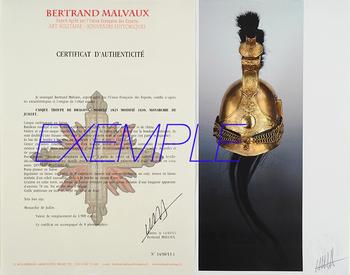
Next update Friday, april 4th at 1:30 PM
FOR ALL PURCHASES, PAYMENT IN MULTIPLE CHECKS POSSIBLE
bertrand.malvaux@wanadoo.fr 06 07 75 74 63
An authenticity certificate of the item including the description published on the site, the period, the sale price, accompanied by one or more color photographs is automatically provided for any item priced over 130 euros. Below this price, each certificate is charged 5 euros.
Only items sold by me are subject to an authenticity certificate, I do not provide any expert reports for items sold by third parties (colleagues or collectors).


